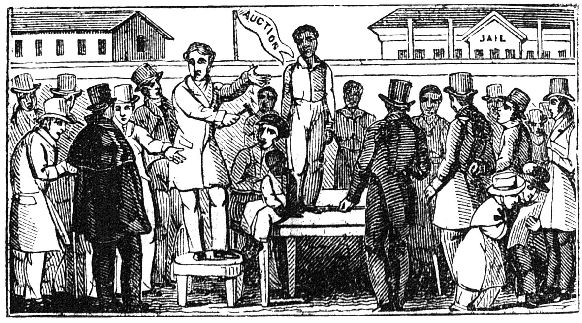
The Second Middle Passage: "Sold Down the River"
A Deep South delegate to the 1787 U.S. Constitutional Convention clearly stated the advantage Old Dominion sellers of enslaved people might have if the proposed Constitution prohibited all African importation into the United States. The consequence, he said, was that “slaves of Virginia would rise in value, and we should be obliged to go to your markets.” The U.S. prohibition that became law on January 1, 1808, proved the delegate’s point. By the early 1800s, the same James River and other Old Dominion rivers on which the slave ships had carried Africans into the colony now helped interstate slave traders find new markets in the Deep South. This time the ships went downriver into the Atlantic to ports like New Orleans. The phrase "sold down the river" speaks volumes about forced family separations and the personal dislocation that the interstate slave trade caused. (Virginia Governor Henry Lee learned in 1792 that one reason for slave rebelliousness in Norfolk and on the Eastern Shore was the “practice of severing husband, wife, and children in sales.”) The interstate trade used land routes too; by the 1850s enslaved people were even loaded onto trains headed for the lower South cotton and sugar plantations. While it can be difficult to distinguish between enslaved people taken to the South by their migrating owners and those sold South, historians have estimated that 300 to 350 thousand Old Dominion men, women, and children were sold South.12 The traders dealt in human commodities. One early advertisement reflects an interstate slave trader’s attitudes, both economic and social: “One Hundred Negroes, from 20 to 30 years old, for which a good price will be given. They are to be sent out of the state, therefore we shall not be particular respecting the character of any of them—Hearty and well made is all that is necessary.”13

Richmond became the second largest (after New Orleans) intrastate and interstate slave trading locality in the United States by the 1840s. It would be very instructive to learn how many of the people “sold down the river” were transported out of Richmond. Available numbers are not completely inclusive or conclusive. But they do indicate very heavy involvement of Richmond traders in the interstate slave trade. There are other ways to estimate the interstate slave trading power of the Richmond dealers. As Frederic Bancroft’s early study Slave Trading in the Old South made clear, there was a highly organized slave trade market in Richmond by the 1830s. Tadman and Bancroft both identify the most prominent traders and specify the earning power of some. These two historians used a mother lode of account and business records for the most successful traders. Those records are replete with transactions concerning black people who were sold to traders bound for the Deep South, including, especially, New Orleans. Finally, simple demographic data suggest the impact interstate slave trading had on enslaved people in Virginia. Enslaved black Virginians continued to reproduce themselves for some time—i.e., achieved natural increase as a group—especially after the Old Dominion closed the transatlantic slave trade. But it is striking that their numbers began to increase significantly less in the 1820s, decreased (for the first time) in the 1830s, and increased by only 5 percent in the 1840s and 4 percent in the 1850s. General health conditions may even have improved by the 1830s, yet there was still a population loss.14

Slave Population Growth and Decline, Virginia, 1800-1859: Census Decade Percent Change
- 1800-1809 +14
- 1810-1819 +8
- 1820-1829 +10
- 1830-1839 - 4
- 1840-1849 +5
- 1850-1859 +4

Enslaved Virginians also experienced a disastrous personal loss because of the interstate slave trade. A cynical, abusive, profit-dominated, dismissive and inhumane cast of mind among slave traders conflicted with their need to sell “a good product.” Too often sales techniques had the primary purpose of minimizing potential buyers’ rejection of some people who were on sale. Some of the most vivid and damning descriptions of slave traders’ habitual methods and attitudes are the documents they left behind. Most of them are inventories of enslaved people on sale; others are letters to and from other slave dealers in the South.15 [http://www.library.vcu.edu/jbc/speccoll/slavery/Slavetrade.html]

I am sure this post has touched all the internet viewers, its really really pleasant article on building up new website.
ReplyDeleteMy page: bankruptcy laws In florida
I am regular reader, how are you everybody? This piece of writing posted at this web page is truly good.
ReplyDeleteMy web site www.officielairjordan2013.com
Wonderful blog! Do you have any tips and hints for aspiring writers?
ReplyDeleteI'm hoping to start my own website soon but I'm a little lost
on everything. Would you advise starting with a free platform like Wordpress or go for a paid
option? There are so many options out there that I'm totally overwhelmed .. Any recommendations? Kudos!
My blog; More hints
I have read so many posts on the topic of the blogger
ReplyDeletelovers but this article is truly a good paragraph, keep it up.
Feel free to visit my web page ... Louis Vuitton Handbags